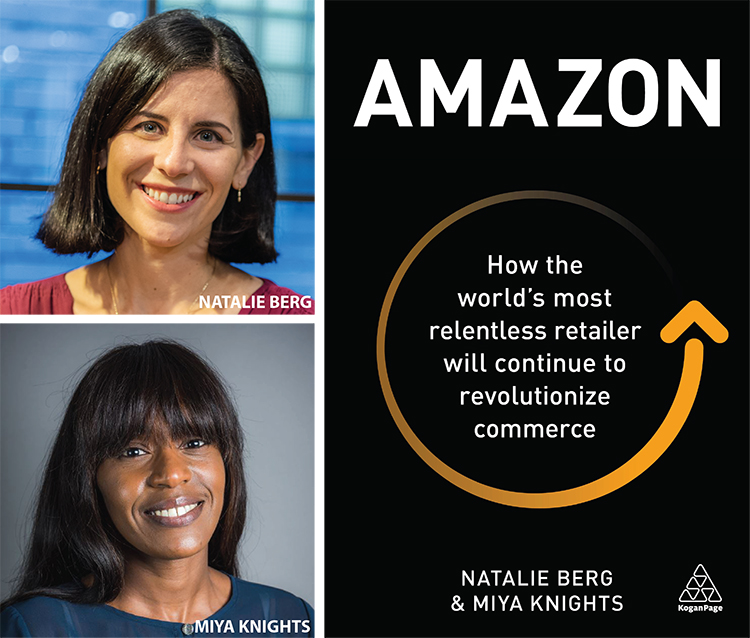How Amazon changes the world of commerce
“It’s an Amazon world!” This is truer than ever. Amazon is not only one of the world’s largest e-commerce companies, but also one of the most relentless retailers and innovators in the retail market. Amazon is pushing into new market segments, challenging other e-commerce players as well as brick-and-mortar retailers.

Natalie Berg and Miya Knights, co-authors of the recently published book “Amazon: How the world’s most relentless retailer will continue to revolutionize commerce”, offer insight into the way the e-commerce giant is transforming the world of commerce, while showing how other retailers can compete.
Natalie Berg, Miya Knights “Amazon: How the world’s most relentless retailer will continue to revolutionize commerce”
While many equate this effect with the disappearance of smaller retailers, it turns out the reality can be different. “[…] retailers should focus on what the so-called ‘Amazon effect’ means to their business: that is, how to deliver and capitalize on heightened tech-driven consumer expectations,” Knights recently said in an article at Forbes. In their book, Berg and Knights “[…] urge retailers and brand to learn from Amazon’s innovation and apply those learnings to excel at ‘what Amazon can’t do’ (#WACD), which is service, experience, curation and community – all elements of the shopping experience that should already be important differentiators for regional retailers and/or those focused on a particular sector […].”
What Amazon Can’t Do
The acronym WACD represents the tactics competitors can employ to survive, while simultaneously providing a means of thriving, despite Amazon’s dominance. The challenges Amazon faces going forward offer opportunities for other retailers.
Natalie Berg, Miya Knights “Amazon: How the world’s most relentless retailer will continue to revolutionize commerce”
Amazon is extremely customer-centric in everything they do. “They are continuously looking for better ways of serving their customers and making the shopping experience even more convenient,” write Berg and Knights. A frictionless and personalized experience is particularly important and connects every aspect of WACD. Amazon’s shopping experience is highly functional but can also be very sterile and impersonal. Amazon is most successful as a transactional commodity site and as a technology company, representing an opportunity for competitors to reposition themselves to be more than just a place to shop and add personality and soul to their shopping experience.

This trends towards a more blended retail experience that merges online and offline. Consumers want to buy both online and in stores. Amazon knows that the future of retail will be omnichannel, which according to Berg, can “[…] marry the best of both worlds”. “Bricks & mortar retail is learning to defend market share by digitising their physical infrastructure.”
Natalie Berg, Forbes
This shows how significant the combination of online and offline is. The see-and-feel aspect is something only physical stores can provide. In addition, stores can serve as pick-up and/or return points for online orders. On the one hand, this helps to reduce shipping costs and at the same time attracts customers to the stores.
According to Berg and Knights, “[…] technologies […] are helping to break down the barriers between online and offline retail.” There are many ways to use technology to provide not only a convenient but also a more personalised and fun shopping experience. That is exactly what consumers want and expect.
To name just a few examples: Using mobile devices and apps as assistants to navigate through stores, find products and additional information, provide personalised recommendations, and more; interactive dressing rooms with smart mirrors and screens; and, Augmented Reality, Virtual Reality and 3D visualisations can also optimise the shopping experience both in-store and online.
Amazon uses AI in its Amazon Go stores to enable consumers to just walk in, pick up products, and walk out without going through a checkout. Their Amazon account is automatically charged when they leave. But other retailers are also benefitting from technology. Walmart experiments with robots that scan shelves for missing items, items that need to be restocked or price tags that need to be changed. And H&M uses data from store receipts and returns to evaluate shopper purchases at each store and refine local advertising and inventory strategies.
What does all this mean for visual content?
The digital transformation of stores will enrich the customer experience, according to Berg and Knights. In e-commerce as well as in retail, visual content is indispensable for marketing, advertising, branding and more and contributes to the customer experience. The possibilities that arise from this transformation process for visual content are enormous. There are basically few limits to creativity.
Miya Knights for Br24
On the other hand, vendors who want to use Amazon as a marketplace for their own products need to ensure that their visual content and product images meet Amazon’s specific requirements. In image editing, the demand to adapt images to meet these standards increases. Thus, Amazon, like all other online marketplaces as well, ensures a seamless and better shopping experience for its own customers.
The power of user-generated content is another important factor. This includes ratings and reviews, as well as visuals. The majority of consumers base their purchasing decision on this type of content. Mobile devices make it easy to snap photos and videos of everything, including products, and share them on social media platforms and communities like Instagram, Snapchat, Pinterest, Facebook, Twitter. It would be fatal to ignore this huge marketing potential. With Amazon Spark, Amazon even created its own social media platform that is centred around visuals and shopping.
Social media friendly displays in stores, having online images that can be shared easily, interacting with customers when they share your content and products, and of course your own presence on the platforms and channels. All this helps retailers to generate traffic, brand awareness, and revenue. And requires appropriate visual content.
“Amazon: How the world’s most relentless retailer will continue to revolutionize commerce”, published by Kogan Page, is available now.
- 2023
- January (1)
- 2022
- December (2)
- November (1)
- October (2)
- September (2)
- August (1)
- July (1)
- June (1)
- May (1)
- April (1)
- March (1)
- February (1)
- January (3)
- 2021
- December (2)
- November (1)
- October (3)
- September (2)
- August (1)
- July (3)
- June (1)
- May (2)
- April (1)
- March (1)
- February (2)
- January (4)
- 2020
- December (2)
- November (3)
- October (4)
- September (1)
- August (2)
- July (1)
- June (2)
- May (3)
- April (3)
- March (3)
- February (4)
- January (4)
- 2019
- December (1)
- November (2)
- October (5)
- September (1)
- August (3)
- July (2)
- June (2)
- May (3)
- April (2)
- March (3)
- February (2)
- January (4)
- 2018
- December (2)
- November (2)
- October (3)
- September (3)
- August (2)
- July (2)
- June (2)
- May (1)
- April (1)
- March (2)
- February (3)
- January (2)
- 2017
- December (2)
- November (2)
- October (1)
- September (1)
- August (1)
- July (1)
- June (1)
- May (1)
- April (1)
- March (1)
- February (1)
